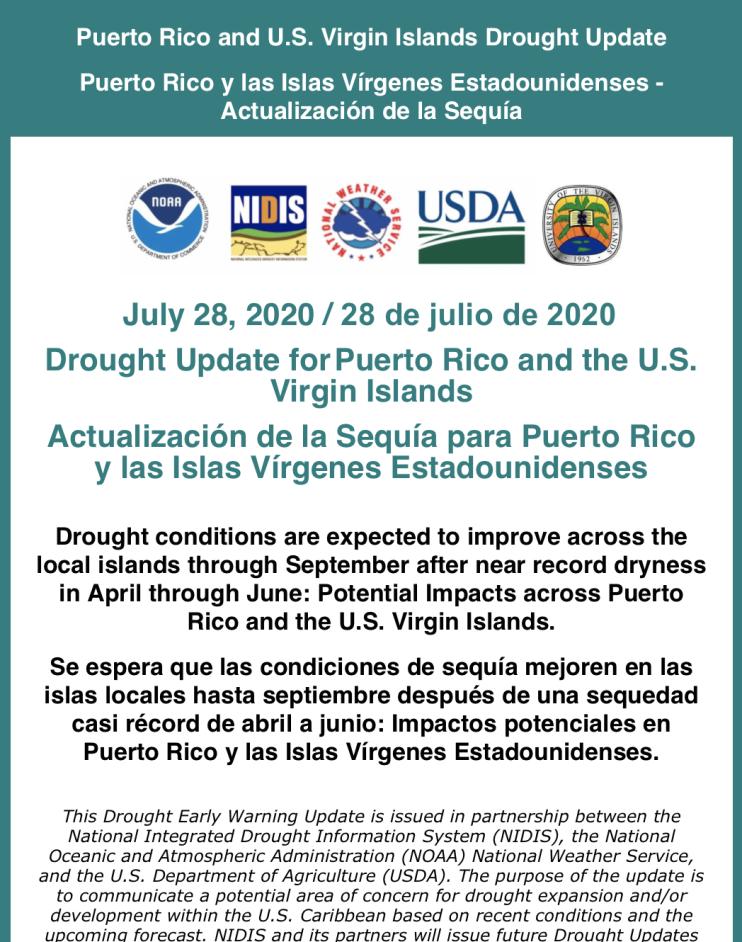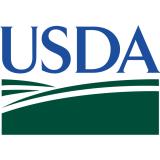Drought Update for Puerto Rico and the U.S. Virgin Islands: July 8, 2020
This Puerto Rico and U.S. Virgin Islands drought early warning update was originally sent via email on July 28, 2020.
Drought conditions are expected to improve across the local islands through September after near record dryness in April through June: Potential Impacts across Puerto Rico and the U.S. Virgin Islands.
Se espera que las condiciones de sequía mejoren en las islas locales hasta septiembre después de una sequedad casi récord de abril a junio: Impactos potenciales en Puerto Rico y las Islas Vírgenes Estadounidenses.
This Drought Early Warning Update is issued in partnership between the National Integrated Drought Information System (NIDIS), the National Oceanic and Atmospheric Administration (NOAA) National Weather Service, and the U.S. Department of Agriculture (USDA). The purpose of the update is to communicate a potential area of concern for drought expansion and/or development within the U.S. Caribbean based on recent conditions and the upcoming forecast. NIDIS and its partners will issue future Drought Updates as conditions evolve.
This update covers Puerto Rico and the U.S. Virgin Islands.
Esta Actualización de Alerta Temprana de Sequía se emite en colaboración entre el Sistema Nacional Integrado de Información de Sequía (NIDIS, por sus siglas en inglés), el Servicio Nacional de Meteorología de la Administración Nacional Oceánica y Atmosférica (NOAA, por sus siglas en inglés), y el Departamento de Agricultura de los Estados Unidos (USDA, por sus siglas en inglés). El propósito de la actualización es comunicar un área potencial de preocupación para la expansión y/o desarrollo de la sequía dentro de los territorios del Caribe pertenecientes a los Estados Unidos según las condiciones recientes y el pronóstico próximo. NIDIS y sus colaboradores emitirán futuras Actualizaciones de Sequía a medida que evolucionen las condiciones.
Esta actualización cubre Puerto Rico y las Islas Vírgenes Estadounidenses.
Key Points
- Drought began in the U.S. Caribbean in April, and peaked in late June/early July. As of July 21st, both Puerto Rico and the U.S. Virgin Islands (USVI) have areas of severe drought, based on the U.S. Drought Monitor.
- While near normal rainfall has been observed over the past few weeks across the local area, rainfall deficits continue to be observed across Puerto Rico and the U.S. Virgin Islands.
- Low soil moisture and below normal streamflows continue across eastern Puerto Rico as well as areas in the southern slopes of the island. Low water levels are still observed at some reservoirs and aquifers, particularly across eastern Puerto Rico.
- Agricultural businesses are still struggling to provide appropriate feed and water to their livestock and crops, particularly across the U.S. Virgin Islands.
- Looking Ahead: Conditions are starting to improve, with additional rain likely coming to PR and USVI later in the week due to current tropical activity and the potential of a tropical cyclone. For weather and storm information specific to your area, please monitor products issued by the National Weather Service in San Juan Puerto Rico and the National Hurricane Center.
- There are enhanced chances to observe near to above normal rainfall during July-August-September across the northeast Caribbean, therefore, drought improvement is expected to continue in the fall.
Puntos Clave
- La sequía comenzó en los territorios de los Estados Unidos en el Caribe en abril y alcanzó su punto máximo a finales de junio a principios de julio. A partir del 21 de julio, tanto Puerto Rico como las Islas Vírgenes Estadounidenses (USVI, por sus siglas en inglés) poseen áreas bajo sequía severa, según el Monitor de Sequía de los Estados Unidos.
- Si bien se han observado lluvias cerca de lo normal en las últimas semanas a través del área local, se siguen observando déficits de lluvia en Puerto Rico y las Islas Vírgenes Estadounidenses.
- La baja humedad del suelo y los flujos de corriente hídrica por debajo de lo normal continúan a través del este de Puerto Rico, así como en áreas de las laderas del sur de la isla. Aún se observan bajos niveles de agua en algunos embalses y acuíferos, particularmente en el este de Puerto Rico.
- Las empresas agrícolas aún luchan por proporcionar alimentos y agua adecuados para su ganado y cultivos, particularmente en las Islas Vírgenes Estadounidenses.
- Mirando hacia el futuro: Las condiciones están comenzando a mejorar con una tormenta tropical y el potencial de llevar lluvia adicional a Puerto Rico y las Islas Vírgenes Estadounidenses a finales de la semana. Para obtener información sobre las condiciones del tiempo y las tormentas específicas de su área, favor de referirse a los productos provistos por el Servicio Nacional de Metereologíaen San Juan, Puerto Rico y el Centro Nacional de Huracanes.
- En la región noreste del Caribe, ha aumentado la probabilidad de que se observen niveles de lluvia normales o por encima de lo normal durante los meses de julio, agosto y septiembre; por lo que se espera que en otoño continúen mejorando las condiciones de sequía.
Prepared By
Odalys Martinez
Senior Service Hydrologist, NWS Weather Forecast Office San Juan
Meredith Muth
NOAA/National Integrated Drought Information System (NIDIS)
William Gould, Nora Alvarez, and Eva Holupchinski
USDA Caribbean Climate Hub, USFS International Institute of Tropical Forestry
Christina Chanes, Gregory Guannel
University of Virgin Islands
Victor Murphy
Climate Services Program Manager, National Weather Service Southern Region






